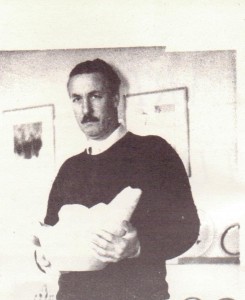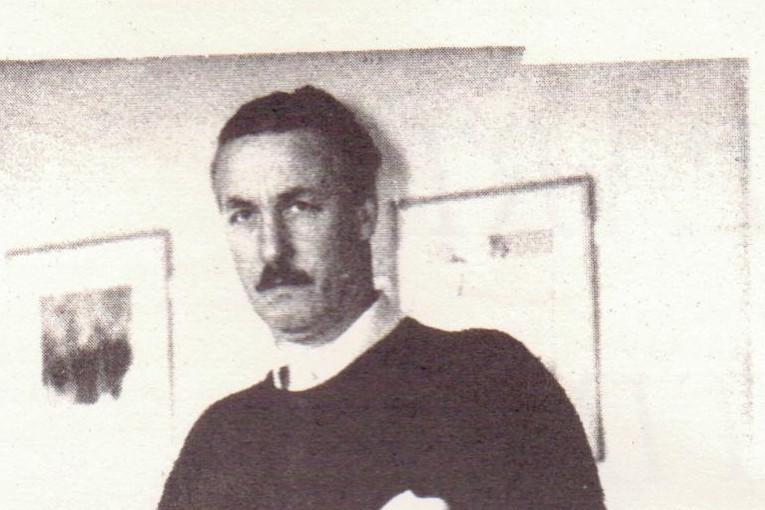Walter Cole
By A. G. Page
The life of Walter Cole the Potter is fairly decisively divided into two parts. Before the War he built a reputation in London as one of the few British specialists in stoneware. whose popularity, in the sophisticated thirties, had declined because of its folksy origin. He led the field, through not only the materials he used, but also in his art grounding—being trained not as a potter but as a sculptor; something which is clear even in his work today.
In 1947 he turned his back on the production of individual pieces and came to Rye, where the old Rye Pottery had recently demised. His reasons for doing so were various but somehow boiled down to a logical sequence which goes something like this: “There is now a market for decent pottery. I believe 1 can produce better pottery than is available. Therefore I can produce pottery which I like, and sell it.” This was neither pompous civic-mindedness or sheer self regard—he merely considered it a matter of fact, as events have borne out.
He could of course have produced the old green and brown Cadborough ware and made a successful living. He embarked instead on applying himself to educating (he hates the word) the public away from those appalling floral incantations that passed for post-war china to something quite new on the tea table— studio pottery. At first this was not easy. Purely financial problems limited public taste until the mid fifties, but progress, if not hectic was at least satisfying.
Walter Cole himself would be the first to admit that it wasn’t a completely one-sided struggle. He has been influenced continuously by the general taste. To survive he argues one cannot be too out of line with demand. His explanation of the push-pull of consumption was lucid and thoughtful. As Mrs. Cole explained they had come to think of it symbolically as a vast pyramid. At the top are those vastly expensive pieces you gaze at wonderingly in art galleries. Gradually thereafter the triangle broadens towards its base as public demand grows and prices fall. What every manufacturer has to do (he might swear and curse at having to admit it) is get as near the top of the pyramid of public taste to still remain economicallv viable. No hypocrisy here—just common sense.
Anyway, the mission’ (I shall annoy him by calling it that but 1 think it deserves explanation simply because it IS so meritorious) seems to be working to everybody’s satisfaction—production has shot up violently over the past few years and the peak of the boom still has not been reached.
He, like Dennis Townsend (who was Walter Cole’s first apprentice) has buyers from all over the country and export orders are running ahead of production. But he, unlike Townsend, does not admire the Swedish pottery. He believes that their pre-eminence is due to the fact that they faced virtually no competition after the war. His inspiration is almost entirely British.
Mr. Cole has been careful not to increase the size of his working unit. Twelve has been the size of his staff for many years but demand has been met by increased efficiency and standardising some lines. Both the Coles believe in cost-effectiveness. This he doesn’t think is a bad thing. He admits that if he could have his way everything he produced would be different— but this just isn’t possible. Providing the design is good then twelve identical are twelve good pieces. Simple. He gives all the freedom to throwers and decorators that he is able and makes as much studio work as he can.
The Pottery manufactures a high percentage of stoneware, and his affection for it over the years hasn’t abated. “Everything over twelve hundred and fifty (the lowest firing heat for stoneware) is beautiful,” he murmured with apostolic reverence.
One recent development has touched his ironic sense of humour. The very Cadborough glaze that he so purposefully kicked out in 1947 has returned. He finds it the perfect foil for the aloof reservation of stoneware. He sees it as an obvious example of the evolution of public taste.
Some Rye designs (and one in particular) I confess struck me as mediocre. A certain coffee pot looked as if a neurotic bluebottle had danced a foxtrot up and down it dragging the paintbrush behind him; its multitudinous garishness leapt out of the shelf and irritated me. Closer inspection relieved some of my internal annoyance, however, and I suppose in truth I liked the others around it so much that its proximity to them had made the pattern seem more offensive than it really was.

My special affection falls to the recently introduced flower designs (NOT flower power) in Rye ware. I suppose some would scream “pretty” but this to me is no term of abuse. One of the worst things about the contemporary arts scene is the dogmatism of those clever people who think pottery should be art nouveau or Scandinavian or just plain bloody ugly.
Whatever critics say, in a highly competitive market you cannot produce rubbish and get away with it. To sell today—like Rye Pottery— it just has to be better than most. Moreover to be a thinking man like Walter Cole and to be satisfied (not self-satisfied) about your work to the degree he is speaks of comprehensive achievement. On that issue it would be fatuous to say more.
To be generous with praise is not to nullify its significance. I could say so much about the design and decoration in Rye Pottery but I won’t because you can go and see it for yourself. Personally I don’t think the standard is a matter of contention. I shall therefore end by saying that the most significant thing about Rye Pottery is Walter Cole, who believes (bless him) in human progress. Exeat, stunned by my own imagination.
“Rye’s Own” February 1968
All articles, photographs and drawings on this web site are World Copyright Protected. No reproduction for publication without prior arrangement. © World Copyright 2015 Cinque Ports Magazines Rye Ltd., Guinea Hall Lodge Sellindge TN25 6EG
